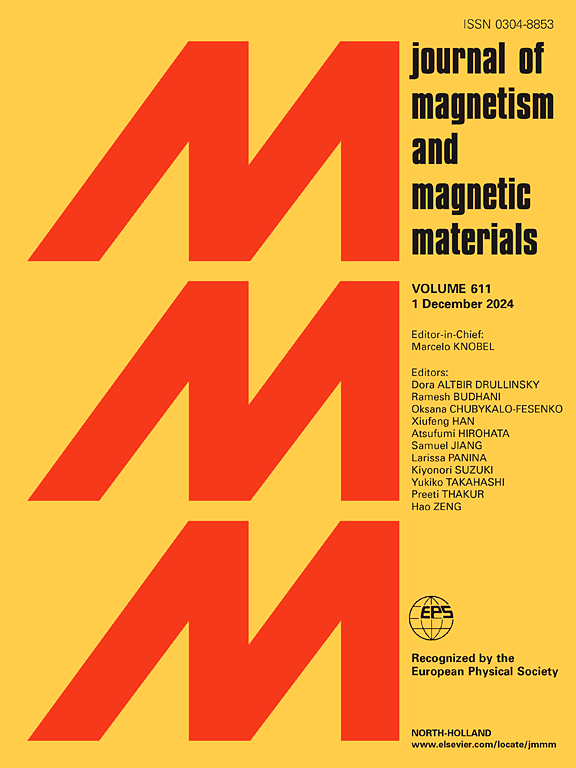Co/h-BN异质结构的磁各向异性:第一性原理计算
IF 2.5
3区 材料科学
Q3 MATERIALS SCIENCE, MULTIDISCIPLINARY
引用次数: 0
摘要
磁各向异性(MA)是磁性薄膜在自旋电子学器件(如磁阻随机存取存储器(mram)和磁场传感器)中的重要特性。垂直MA更适合MRAM,而平面MA更适合磁场传感器应用。六方氮化硼(h-BN)作为六方对称磁隧道结的有效势垒,近年来受到广泛关注。在本研究中,用第一性原理计算理论研究了沉积在h-BN上的Co薄膜的磁各向异性。观察到,对于包含1 ~ 5个Co原子层的薄膜,实现了大量的垂直磁晶各向异性(MCA),其数量级为1 mJ/m2。发现h-BN层在界面处的屈曲结构增强了垂直MCA。还计算了磁偶极子能,并发现在含有2 ~ 5个Co原子层的薄膜中,磁偶极子能引起平面内MA。由单原子Co层组成的薄膜垂直磁化,各向异性常数为1.68 mJ/m2,电压控制的MA系数为-175 fJ/Vm,与Fe/MgO薄膜的各向异性系数相同。在包含2 ~ 5个Co原子层的平面内磁化薄膜的情况下,发现MA能量与平面内角无关,这是传感器应用的优选特性。该结果为Co/h-BN异质结构的MA提供了基础见解,并为开发基于该材料的压控MRAM和磁场传感器奠定了基础。本文章由计算机程序翻译,如有差异,请以英文原文为准。
Magnetic anisotropy of Co/h-BN heterostructures: First principles calculations
Magnetic anisotropy (MA) is an important characteristic of magnetic films for the application of spintronics devices such as magnetoresistive random access memories (MRAMs) and magnetic field sensors. Perpendicular MA is more suitable for MRAM, while in-plane MA is better for magnetic field sensor applications. Hexagonal boron nitride (h-BN) has recently attracted much attention as an efficient tunnel barrier for magnetic tunnel junctions with hexagonal symmetry. In this study, the magnetic anisotropy of a Co thin film deposited on h-BN is theoretically investigated using first-principles calculations. It is observed that a substantial perpendicular magnetocrystalline anisotropy (MCA) of the order of 1 mJ/m2 is achieved for the film comprising 1 5 Co atomic layers. The buckled structure of the h-BN layer at the interface is found to enhance the perpendicular MCA. The magnetic dipole energy is also calculated and is found to cause the in-plane MA for the films comprising 2 5 Co atomic layers. The film comprising a monoatomic Co layer is found to be perpendicularly magnetised with an anisotropy constant of 1.68 mJ/m2 and a voltage-controlled MA coefficient of -175 fJ/Vm, which are of the same order as those for the Fe/MgO film. In the case of in-plane magnetised films comprising 2 5 Co atomic layers, the MA energy is found to be independent of the in-plane angle, which is a preferable characteristic for sensor applications. The results provide fundamental insights into the MA of Co/h-BN heterostructures and a foundation for developing voltage-controlled MRAM and magnetic field sensors based on this material.
求助全文
通过发布文献求助,成功后即可免费获取论文全文。
去求助
来源期刊

Journal of Magnetism and Magnetic Materials
物理-材料科学:综合
CiteScore
5.30
自引率
11.10%
发文量
1149
审稿时长
59 days
期刊介绍:
The Journal of Magnetism and Magnetic Materials provides an important forum for the disclosure and discussion of original contributions covering the whole spectrum of topics, from basic magnetism to the technology and applications of magnetic materials. The journal encourages greater interaction between the basic and applied sub-disciplines of magnetism with comprehensive review articles, in addition to full-length contributions. In addition, other categories of contributions are welcome, including Critical Focused issues, Current Perspectives and Outreach to the General Public.
Main Categories:
Full-length articles:
Technically original research documents that report results of value to the communities that comprise the journal audience. The link between chemical, structural and microstructural properties on the one hand and magnetic properties on the other hand are encouraged.
In addition to general topics covering all areas of magnetism and magnetic materials, the full-length articles also include three sub-sections, focusing on Nanomagnetism, Spintronics and Applications.
The sub-section on Nanomagnetism contains articles on magnetic nanoparticles, nanowires, thin films, 2D materials and other nanoscale magnetic materials and their applications.
The sub-section on Spintronics contains articles on magnetoresistance, magnetoimpedance, magneto-optical phenomena, Micro-Electro-Mechanical Systems (MEMS), and other topics related to spin current control and magneto-transport phenomena. The sub-section on Applications display papers that focus on applications of magnetic materials. The applications need to show a connection to magnetism.
Review articles:
Review articles organize, clarify, and summarize existing major works in the areas covered by the Journal and provide comprehensive citations to the full spectrum of relevant literature.
 求助内容:
求助内容: 应助结果提醒方式:
应助结果提醒方式:


